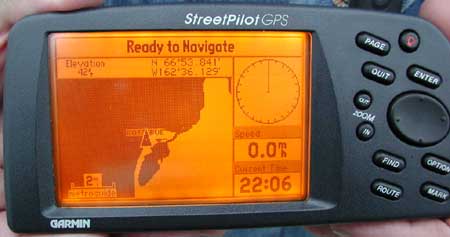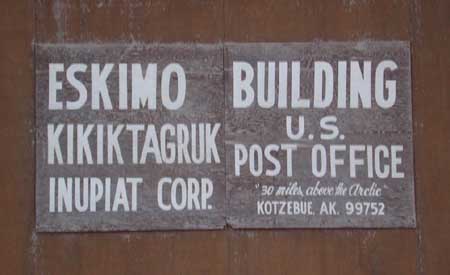 |
| Website Home (Menu del Dia) | ||
| Previous | Alaska Home | Next |
Your Tax Dollars
at Work in Kotzebue, AK:
GPS and the U.S. Postal Service
It's a lame title, but the best I could think of to link the two pictures here. I wanted to include them, but neither belonged anywhere else, so they're together on this page.
 |
Tax dollars at work example #1: the GPS, or Global Positioning System. My Garmin StreetPilot GPS receiver offers evidence of two things: first, that we really were in Kotzebue and second, that even in late August the sun doesn't set until almost 11:00pm, because the picture was taken at 10:06pm with plenty of daylight.
Another common misperception dispelled: Many people who ride in my car and take interest in the Garmin GPS receiver ask if I have to pay for the GPS service. NO - the GPS system is free to use, except for the cost of the receiver, of course. Some companies, such as OnStar, offer GPS-based emergency and navigational services, but you're paying for the human that unlocks your car's doors, gets you to the interstate when you're lost or dispatches a tow truck when your car breaks down. Your federal tax dollars fund the United States Department of Defense which develops and maintains the Global Positioning System. The GPS system was originally designed for military and government use, but one of the goals was to eventually make it available to the public. This goal was met in the spring of 2000 when GPS' Selective Availability was discontinued in North America, increasing the accuracy of commercial GPS receivers to 10 meters or less. As far as I know, GPS is also available to anyone anywhere in the world, although Selective Availability may reduce its accuracy outside North America, but a good receiver should still be accurate to 30 meters.
Selective Availability makes the satellites intentionally send an inaccurate time signal to lower the system's accuracy. The DoD did this until the year 2000 for security reasons; example, a hostile entity using GPS as a weapons guidance system. In the U.S., Selective Availability reduced GPS accuracy roughly threefold, so a good commercial receiver was accurate to 30 meters instead of 10. I never understood how this trivial inaccuracy was supposed to foil the guidance system on a missile targeted at a large structure such as a factory with a 50 meter blast radius warhead, but there are many things I don't understand. If you have insight on how Selective Availability is or was supposed to maintain national security, kindly email me with an explanation. My thanks in advance.
 |
Tax dollars at work example #2: the U.S. Postal Service: to whatever remote locales your travels may take you, always remember to find the post office and send a postcard; I fell obliged to say that since I'm partly responsible for the Postal Service's recent financial difficulties. My bills are paid over the Internet and all my correspondence is by email - I don't even mail Christmas cards!
I think "Kikiktagruk" is the native Inupiat name for Kotzebue, but I'm not sure. The native name, whatever it is, means "almost an island," which it really is two times over, because the Baldwin Peninsula connects to the mainland by a thin strip of land, and Kotzebue itself is on an even thinner strip of land connecting it to the Baldwin Peninsula. This second, thinner strip can be seen on the GPS display above. Kotzebue was named for the German explorer who first discovered the Inupiat dwelling - I'm sure the Inupiats were pleased when they heard they had a village here. The Europeans did great things for the natives and "savages" of the world, don't you think, assisting with their self-discovery and all?
| Website Home (Menu del Dia) | ||
| Previous | Alaska Home | Next |